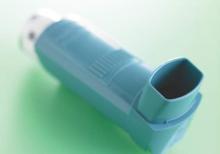Privately insured patients with asthma faced an 81% rise in out-of-pocket costs for albuterol and used slightly less of the medication after the Food and Drug Administration banned chlorofluorocarbon-based inhalers, researchers reported online in JAMA Internal Medicine.
But the ban did not appear to affect rates of hospitalization or emergency department or outpatient visits for asthma, said Dr. Anupam Jena of Massachusetts General Hospital in Boston and his associates. “The impact of the FDA policy on individuals without insurance who faced greater increases in out-of-pocket costs warrants further exploration,” the researchers emphasized.
Concerns about ozone depletion led the FDA in 2005 to announce a ban on CFC inhalers that became effective at the end of 2008. Patients were left with pricier branded hydrofluoroalkane albuterol inhalers, Dr. Jena and his associates noted (JAMA Intern. Med. 2015 May 11 [doi:10.1001/jamainternmed.2015.1665]).
To investigate the economic and clinical effects of this shift, the researchers analyzed private insurance data from 2004 to 2010 on 109,428 adults and 37,281 children with asthma.
The average out-of-pocket cost of an albuterol prescription rose from $13.60 (95% confidence interval, $13.40-$13.70) in 2004 to $25.00 (95% CI, $24.80-$25.20) in 2008, just after the ban went into effect, the researchers reported. By 2010, the average cost of a prescription had dropped to $21.00 (95% CI, $20.80-$21.20). “Steep declines in use of generic CFC inhalers occurred after the fourth quarter of 2006 and were almost fully offset by increases in use of hydrofluoroalkane inhalers,” added the researchers. Furthermore, every $10 increase in out-of-pocket albuterol prescription costs was tied to about a 0.92 percentage point decline in use of the inhalers (95% CI, −1.39 to −0.44; P < .001) in adults, and a 0.54 percentage point in children (95% CI, −0.84 to −0.24; P = .001), they said. Usage did not vary significantly between adults and children or among patients with persistent or nonpersistent asthma, they added.
The National Institutes of Health, National Institute on Aging, and University of Minnesota funded the study. The investigators declared no relevant conflicts of interest.

